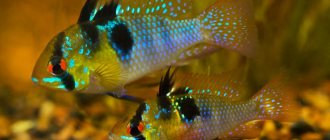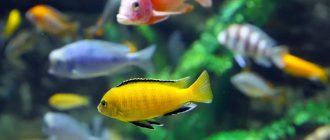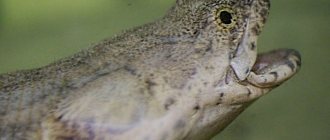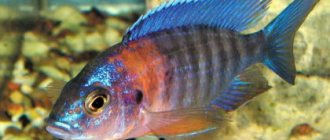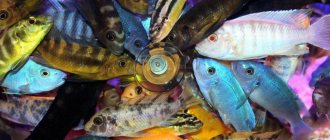Motherland
A beautiful and large predatory inhabitant of the aquarium, which also has other names - water buffalo, peacock eye or Oscar cichlid. The name astronotus is translated from Greek as “ray back”, which is due to the structural features of the fins, the rays of which are directed towards the tail.
The homeland of fish is South America. Under natural conditions, astronotuses live in fresh water bodies of Brazil, Venezuela, Paraguay and Guiana. They are found in the Amazon basin, in the Rio Negro, Parana and Rio Paraguay rivers. These fish also live in stagnant bodies of water. As an imported species, astronotus have successfully taken root in the waters of Florida, Australia and China. There the fish acclimatized well and were able to fully reproduce. In Latin America they are commercially available and valued for their high taste. In the Southern States of the United States, this fish is popular as an object for sport fishing.
Under natural conditions, water buffalo feed on smaller fish. Representatives of the species are particularly aggressive and defend their territory, staging bloody battles if necessary. They choose calm coastal areas of water bodies, where there is a large number of shelters from tree roots. Fish do not like places with strong currents.
These fish were brought to Europe in 1937, and came to the USSR in 1957. Since caring for them is not as difficult as for most other cichlids, astronotus quickly gained popularity among lovers of large aquarium inhabitants.
A pair of astronotuses is not only a beautiful, but also an interesting sight.
Astronotuses are distinguished by high intelligence and interesting behavior. Their appearance is easily recognizable. The fish is large, oval in shape, with a laterally compressed body. The fins are large, slightly elongated. The dorsal and anal fins almost touch the caudal fin. The shape of the caudal fin is rounded. The head is massive, pointed, with a convex forehead area. The mouth is conical in shape with fleshy lips. The teeth are small and numerous. The main color is dark to black with irregularly spaced spots of red-orange color. In a number of individuals they form stripes similar to those of a tiger. Near the caudal fin there is a black round spot with an orange border.
Astronotus fry are similar to their parents despite obvious differences in color.
Juveniles differ significantly in color from adults. The spots on their body are light, almost white. It looks impressive, but as the fish matures, the spots will change color. Breeders today have developed several hybrid forms that have a red body color.
Description
Astronotus is a cichlid. In its natural environment it lives in stagnant South American reservoirs. Astronotuses are considered to be long-livers. In good conditions they can live up to 15 years.
These aquarium fish have a tall body, slightly flattened on the sides, a large forehead and large eyes. In nature, astronotus reaches 35 cm in length. In aquariums they can grow up to 25-30 cm.
The color of the fish from the sides is interesting. The colored spots resemble stars, which influenced its name (from the Latin “astra” - star). However, today breeders have bred a large number of species, each of which has its own unique color.
Astronotuses have some sexual differences, by which one can easily identify a male and a female. Males are always larger, have a wide massive forehead and an elongated anal fin, unlike females. Visually determining the sex is not difficult, the main thing is to know the main signs.
It is not at all difficult to distinguish a female from a male. Males are always larger, have a wide massive forehead and an elongated anal fin, unlike females.
Care and maintenance
| Volume of water (liters per 1 individual) | Temperature (°C) | Acidity (pH) | Hardness (dGH) |
| 200 | 22 — 25 | 6,5 — 7,5 | up to 25 |
The main difficulty in keeping astronotuses is that they require a large aquarium. Its volume starts from 500 liters, since these cichlids are kept in pairs. Sometimes they are placed in smaller containers, but this can be called cruelty to animals, since in such conditions the fish cannot live fully and their life span is short. They don't live to old age. The main reasons for this are the tightness of the fish and frequent illnesses. Large aquarium inhabitants produce a large amount of waste, and if the water volume is insufficient, it will quickly cause poisoning in the fish.
To fully enjoy the beauty of astronotus, you will need a spacious rectangular aquarium!
Sand or large sea pebbles are placed on the bottom of the aquarium. Since astronotuses love to burrow in the ground, it is difficult for living plants to survive with them. If you don’t want to decorate your home pond with plastic plants, then you can try growing hard-leaved, unpretentious species by planting them in pots.
All decorative elements in the aquarium should be firmly fixed. There must be several large snags at the bottom in which fish can hide. The equipment in the container with astronotuses must be firmly fixed so that the fish cannot break it or break the glass with it. Since these large pets are very active and playful, if there are moving heavy elements in the aquarium, the fish can break their home and die.
An aquarium lid is a must. It has two functions: first of all, it will not allow the fish to jump out, which is quite likely in an open reservoir; and secondly, the water will not evaporate or splash too quickly while the inhabitants are playing.
The quality of water in an aquarium is of great importance. It must be renewed every 7 days, changing 30% of the volume. At the same time, the bottom should be cleared of fish feces. This is done using a siphon.
A siphon is a simple but indispensable tool for cleaning aquarium soil; it is especially difficult to overestimate its convenience in caring for large fish!
Also, the aquarium must have high-quality filtration and aeration, but without creating a strong current. It is optimal if an external flow filter is installed. Thanks to this model, the water is actively saturated with oxygen and purified, and there will be no strong current.
The fish should be fed with prepared special diets for predatory cichlids or with live food. Pets are often given earthworms, large bloodworms, small fish and pieces of seafood. Astronotus should not be given meat, since they do not have the enzymes to digest the meat of warm-blooded animals. The best option is to feed with special ready-made industrial food, with weekly feedings in the form of live and/or frozen food.
Use only one type of food per meal!
Feeding
It is better to feed with high-quality artificial food, which can be purchased at a pet store. Feeding astronotus should not be monotonous; you need to pay attention to the food; it is better to additionally give them live and frozen food. Suitable food for astronotus are crickets, shrimp, fish fillets, mussel meat, tadpoles, squid, frogs, grasshoppers, fish such as guppies or veiltails, ox heart and other large foods.
Earthworms are also suitable for feeding, provided that you first leave them in a separate jar in water for 4–5 hours so that their intestines are cleared of soil.
It is better to diversify with plant foods: mashed black bread, rolled oats, spinach or lettuce.
Astronotus is a rather greedy aquarium fish; you should not overfeed it. Believe me, they can eat more than normal, but it won’t make them any better. In principle, aquarium hobby considers it a golden rule that fish should not be overfed. It is better to feed them once a day and sometimes have fasting days.
Compatibility
The optimal option for keeping astronotuses is a species aquarium, in which, depending on its size, two fish or a group will live. This is due to the fact that the aggressiveness of the species is very high. If the aquarium is very large, then it is possible to add other large predatory cichlids to the astronotus, which will not be perceived as food. In this case, the territory will be divided between pairs, and dangerous conflicts between inhabitants will not occur. However, this only applies to cases where the fish grow together. If you add neighbors to adult astronotuses, then in most cases this will end in the death of the new inhabitants.
The compatibility table applies to all cichlids, and not specifically to astronotuses, but quite accurately shows the relationship of these giants with their neighbors.
Neighbors, which are the size of an astronotus’s mouth, are perceived by it exclusively as food. Even if a cichlid is raised with other small fish, once it reaches a certain size, the neighbors will become food.
An interesting neighborhood option for a large aquarium is natural neighbors, i.e. fish in nature live side by side.
Who do they get along with in the aquarium?
You need to be careful when decorating a fish house - this subspecies simply loves to explore new territory and can dig up the soil or even arrange rearrangements to suit its taste. It is better to pick up several large snags, stones or shelters. Despite their size, these fish are quite shy and need a place to hide.
For planting, you should choose Thai ferns or Echinodorus. It is recommended to bury artificial plants in the ground and weigh them down with small weights. Vegetation with sharp edges should not be planted; fish may be injured by them. It is better to fill the bottom of the aquarium with pebbles or coarse sand. You can also try gravel.
Neighbors should be chosen carefully. It is best to make a species-specific aquarium, but in principle, representatives of this species get along well with large fish (for example, cichlids). Problems can only arise when they reach sexual maturity, during which time water buffalos can show unexpected aggression. When moving in, you need to remember that astronotus can hunt for small relatives (guppies or neons).
Diseases
Astronotus are strong fish that, if kept properly, usually do not suffer from diseases. However, in some cases, pathologies may appear in pets. The main ones are the following:
- lateral line erosion;
- erosive head injuries;
- intestinal blockage - if the pebbles in the aquarium are small and the fish swallows them while digging. Not all stones can pass through the intestines and come out naturally, which is why a blockage develops. The sick individual rests on the bottom, its stomach is swollen. Sometimes you can save your pet by adding a small amount of table salt to the aquarium water;
- hole disease.
All of these diseases arise due to improper maintenance. They can be caused by too infrequent water changes, insufficient aeration or excessively strong flow caused by the filter. Poor, unbalanced nutrition is also dangerous for fish health. Be attentive to your fish and they will delight you for a long time!
Why do astronotus shake their tail?
Those who have recently started working with aquarium fish have questions about their maintenance and behavior. For example, it is interesting why the aquarium fish Astronotus shakes its tail and fins. Perhaps this is how they show off in front of each other or prepare for spawning. If this is the case, then you need to prepare everything necessary for reproduction. Astriks often challenge each other to fight by shaking their tail, but this behavior of the fish may also indicate the onset of a disease that can arise due to improper maintenance.
Reproduction
Breeding these cichlids is not difficult if kept correctly. The pair spawn regularly if the fish are not stressed. There are no externally noticeable sexual differences between males and females. The sex of fish can only be distinguished by their behavior after a pair has formed. They reach sexual maturity at the age of 2 years, when the body size is 10-15 cm. Spawning is stimulated by an increase in water temperature. The female can lay up to 1000 eggs at a time. If fish are stressed after spawning, they are more likely to eat eggs or already hatched fry.
05:29
ASTRONOTHUS. MAINTENANCE AND BREEDING IN THE AQUARIUM
It is common for astronotus to take care of the young. The larvae hatch 3-8 days after spawning. The fry begin to swim independently after 6-11 days. Young fish grow unevenly, and therefore it is necessary to regularly place the fry, sorting them by size, so that large fish do not kill smaller ones. The water in the container where the astronotuses grow is changed daily in a volume of 1/5 of the total.
Why do astronotuses change color?
It happens that the astronotus changes the color of its body, becoming paler. This may occur during times of danger or stress. In addition, fish often change color during the mating season. These are all natural processes that should not cause concern to the aquarist. It’s another matter when a change in the shade of the astronotus occurs as a result of improper maintenance conditions: lack of filtration, aeration, inappropriate aquarium size, and so on. Correct all the shortcomings, and the fish will become bright and beautiful again.
Popular types
Red
A breeding form in which the orange-red color covers almost the entire body. A dark haze is present on the fins. The variety was obtained by a Thai breeder.
Albino
The general body color is white. The spots are orange or red. The dark pigment in the color is completely absent.
Veiled
Selected hybrid form with veil fins.
Gold
The rarest elite species. The color distribution is similar to that of red, but the main tone is not red, but gold.
Super ed
A variety of the red form of Astronotus, in which a very bright red tone covers the entire body of the fish.
Lyutino
Externally, the variety is similar to albinos, but they do not completely lack dark pigments. They are especially noticeable in the area of the ends of the fins. The fish may also have dark or greenish spots. The eyes are always dark.
brindle
The most popular species among aquarists. The general tone of the scales is brown or dark gray, and the spots are bright orange or crimson. This type of fish is not a hybrid, and if desired, it can be bred in your own aquarium.
Breeders are constantly working to create new species of astronotus.
These cichlids are not the best choice for beginners, as they require strict care and a large aquarium. For experienced breeders, such pets will become a new and interesting experience.
Reviews
I’ve been interested in aquariums for a long time and finally decided to buy a couple of astronotuses. The fish have very interesting behavior and, in principle, are not difficult to care for if you immediately set up an aquarium with everything you need. Victor, 52, Ekaterinburg
I have long wanted to try keeping astronotuses and, having moved to a new house, I was able to set up a large aquarium with these beauties. I bought an adult pair from an ad. At first the fish were stressed because of the move, but then they got used to it. It is very interesting to watch such pets. They are already trying to get a divorce, but I don’t know yet what will come of it. I have never regretted having such an aquarium, although I have to constantly tinker with live food. Margarita
